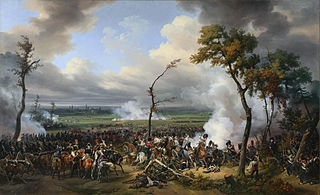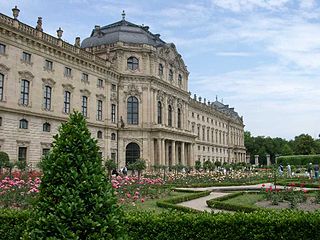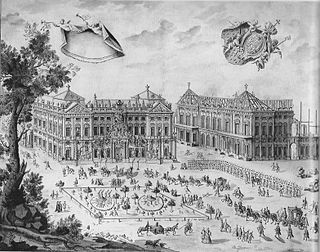
Herrenchiemsee is a complex of royal buildings on Herreninsel, the largest island in the Chiemsee lake, in southern Bavaria, Germany. Together with the neighbouring isle of Frauenchiemsee and the uninhabited Krautinsel, it forms the municipality of Chiemsee, located about 60 kilometres (37 mi) southeast of Munich.

The Nymphenburg Palace is a Baroque palace situated in Munich's western district Neuhausen-Nymphenburg, in Bavaria, southern Germany. The Nymphenburg served as the main summer residence for the former rulers of Bavaria of the House of Wittelsbach. Combined with the adjacent Nymphenburg Palace Park it constitutes one of the premier royal palaces of Europe. Its frontal width of 632 m (2,073 ft) even surpasses Versailles.

The Battle of Hanau was fought from 30 to 31 October 1813 between Karl Philipp von Wrede's Austro-Bavarian corps and Napoleon's retreating French during the War of the Sixth Coalition.

The Würzburg Residence is a palace in Würzburg, Germany. Johann Lukas von Hildebrandt and Maximilian von Welsch, representatives of the Austrian/Southern German Baroque style, were involved in the construction, as well as Robert de Cotte and Germain Boffrand, who were followers of the French style. Balthasar Neumann, court architect of the Bishop of Würzburg, was the principal architect of the Residence, which was commissioned by the Prince-Bishop of Würzburg Johann Philipp Franz von Schönborn and his brother Friedrich Carl von Schönborn in 1720, and completed in 1744. The Venetian painter Giovanni Battista Tiepolo, assisted by his son, Domenico, painted frescoes in the building.

Marienberg Fortress is a prominent landmark on the left bank of the Main river in Würzburg, in the Franconia region of Bavaria, Germany. It is a symbol of Würzburg and served as a home of the local prince-bishops for nearly five centuries. It has been a fort since ancient times, although most of the current structures were built in Renaissance and Baroque styles between the 16th and 18th centuries. After Gustavus Adolphus of Sweden conquered the area in 1631 during the Thirty Years' War, the castle was reconstructed as a Baroque residence. After it ceased to serve as residence of the Bishops of Würzburg, the fortress saw repeated action in the wars of the late 18th and 19th centuries. It was severely damaged by British bombs in March 1945 and only fully rebuilt in 1990. Today, it houses two museums.

The Prince-Bishopric of Würzburg was an ecclesiastical principality of the Holy Roman Empire located in Lower Franconia, west of the Prince-Bishopric of Bamberg. Würzburg had been a diocese since 743. As established by the Concordat of 1448, bishops in Germany were chosen by the canons of the cathedral chapter and their election was later confirmed by the pope. Following a common practice in Germany, the prince-bishops of Würzburg were frequently elected to other ecclesiastical principalities as well. The last few prince-bishops resided at the Würzburg Residence, which is one of the grandest Baroque palaces in Europe.

Residenz is a German word for "domicile", now obsolete except in the formal sense of an official residence. A related term, Residenzstadt, denotes a city where a sovereign ruler resided, and thus carries a similar meaning to the contemporary expressions seat of government or capital. As there were many sovereign rulers in the Holy Roman Empire, ranking from lord (Herr) to prince elector and king, there are many cities, palaces, and castles in the empire's former territory which used to be a Residenz, some of which are still so referred to today. The former status of a city as a Residenz is frequently reflected in the architecture of its center. During the baroque period especially, many prestigious buildings were erected; sometimes even new towns were founded. Most former Residenzstädte still serve as cultural and administrative centers today.

The Residenz in central Munich is the former royal palace of the Wittelsbach monarchs of Bavaria. The Residenz is the largest city palace in Germany and is today open to visitors for its architecture, room decorations, and displays from the former royal collections.

The Kingdom of Bavaria was a German state that succeeded the former Electorate of Bavaria in 1806 and continued to exist until 1918. With the unification of Germany into the German Empire in 1871, the kingdom became a federated state of the new empire and was second in size, power, and wealth only to the leading state, the Kingdom of Prussia.

Werneck is a market town in the district of Schweinfurt in Lower Franconia, Bavaria, Germany. It has a population of around 10,000 and is best known for its Baroque palace, Schloss Werneck.

Ellingen is a town in the Weißenburg-Gunzenhausen district, in Bavaria, Germany.

Schloss Johannisburg is a schloss in the town of Aschaffenburg, in Franconia, in the state of Bavaria, Germany. It was erected between 1605 and 1614 by the architect Georg Ridinger for Johann Schweikhard von Kronberg, Prince Bishop of Mainz. Until 1803, it was the second residence of the Archbishop and Prince Elector of Mainz. It is constructed of red sandstone, the typical building material of the Spessart, the hills near Aschaffenburg.

This article gives an overview about the architecture of Munich, Germany.

KarlPhilipp Josef, Prince von Wrede was a Bavarian field marshal. He was an ally of Napoleonic France until he negotiated the Treaty of Ried with Austria in 1813. Thereafter Bavaria joined the coalition.

Würzburg is, after Nuremberg and Fürth, the third-largest city in Franconia located in the north of Bavaria. Würzburg is the administrative seat of the Regierungsbezirk Lower Franconia. It spans the banks of the Main river.

Residenz Ansbach, also known as Markgrafenschloss, is a palace in Ansbach, Germany. It was the government seat of the Margrave of Brandenburg-Ansbach. Today it is the administrative seat of the government of Middle Franconia. The Great Hall and the Orangerie in its garden serve as venues for the biennial music festival Bachwoche Ansbach.

The Willibaldsburg is a spur castle, built around the year 1353, in Eichstätt in Upper Bavaria. Until the middle of the 18th century, it was the representative castle and seat of Eichstätt's prince-bishops.

Schönbusch is a historic park and Schloss near the town of Aschaffenburg in the Franconia region of Bavaria, Germany. The park was designed in the late 18th century as an English landscape garden for an Archbishop of Mainz. Various Neoclassical buildings, including the Schloss are scattered across the park. It is open to the public.

Schloss Seehof is a Schloss (palace) in Memmelsdorf, Bamberg, Germany. It was built from 1684 to 1695 as a summer residence and hunting lodge for Marquard Sebastian Schenk von Stauffenberg, Prince-bishop of Bamberg.

Mergentheim Palace is a historic building located in Bad Mergentheim, Germany. The palace was first a castle, built in the early Middle Ages as the seat of the Taubergau, but then became a Teutonic possession in 1219, and then seat of the Mergentheim Commandery. The castle became the residence of the Grand Master of the Teutonic Order in 1527 and remained the headquarters of the Order until 1809.






















